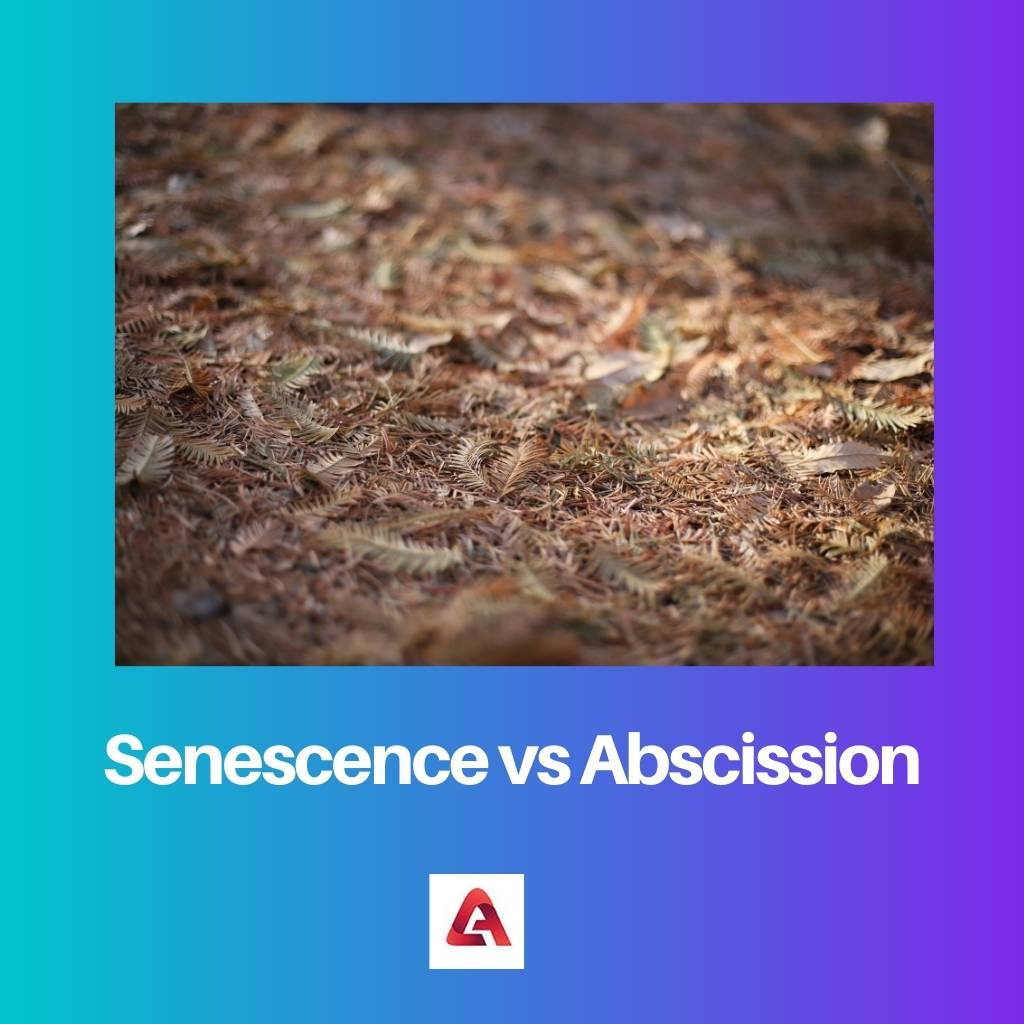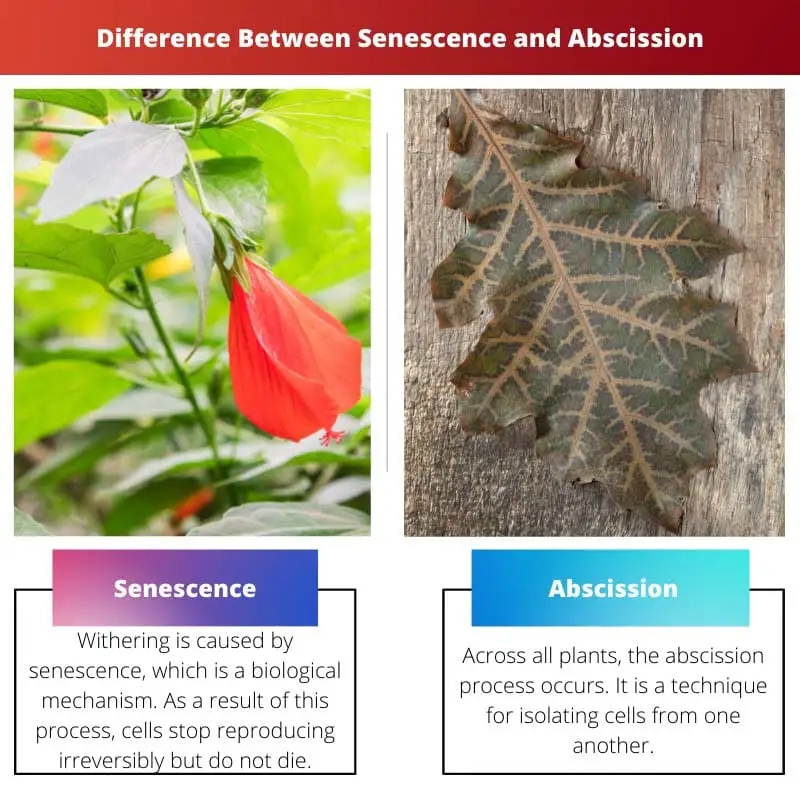Two important cellular functions are abscission and senescence. The separating of plant components from the mother plant is known as abscission.
Senescence is a biological process wherein cells remain in a state of cell cycle inhibition indefinitely. After the creation of an abscission zone at the site of detachment, abscission occurs.
Key Takeaways
- Senescence is the process of cellular aging and deterioration, while abscission refers to the natural detachment of plant parts, such as leaves or fruit.
- Senescence occurs at the cellular level and can lead to the organism’s death, while abscission is a regulated process that benefits the plant’s overall health.
- Abscission is triggered by environmental factors, such as seasonal changes, whereas senescence is a natural part of an organism’s life cycle.
Senescence vs Abscission
The difference between abscission and senescence is that abscission is a basic process by which green plants can release their aerial body parts, like as a leaf, floral, fruit, seed, and stem, as well as others from the mother plant, whereas senescence is a biochemical cycle of life wherein cells irrevocably stop trying to divide and gain entry in a state of perpetual growth arrest without dying.

Senescence is the biological mechanism of withering. It is the procedure through which cells cease proliferating irreversibly and reach a state of persistent growth arrest without dying. As a result, senescence can also be thought of as the final phase of development in plant species.
The abscission process is common in all plants. It is a method of separating cells. It’s a biological process that’s been carefully orchestrated. ABSCISSION: The physical separation of a specific plant part(s) from the mother plant.
A collection of functionally distinct cell types is called an abscission area.
Comparison Table
| Parameters of Comparison | Senescence | Abscission |
|---|---|---|
| Connotation | Withering is caused by senescence, which is a biological mechanism. As a result of this process, cells stop reproducing irreversibly but do not die. Accordingly, senescence can also be viewed as the ultimate stage of plant growth. | Across all plants, the abscission process occurs. It is a technique for isolating cells from one another. Biologically, it’s a well-planned and well-executed process. |
| Death and Protection | The process of Senescence can lead to the partial or the total death of plants. | On the other hand, Abscission protects the plants protects the plants from the verge of death. |
| Effects on Microorganisms | Senescence can never protect plants from any kind of infections. | Whereas, Abscission has a huge impact while protecting the plants from any fungal infections. |
| Association with ageing | Senescence is widely associated with the ageing process in plants. | On the other hand, Abscission isn’t associated with the ageing process. |
| Nutrients in plants | Senescence helps in mobilizing every nutrient from one plant organ to other. | Abscission, on the other hand, minimizes the loss of water and nutrients from the plant body. |
What is Senescence?
Senescence is the biological mechanism of withering. It is the procedure through which cells cease proliferating irreversibly and reach a state of persistent growth arrest without dying.
As a result, senescence can also be thought of as the final phase of development in plant species.
Several plant hormones cause senescence in vegetation, including ethylene and abscisic acid. Senescence can occur at numerous levels, including organ, species, and cellular levels.
Plants transfer resources from ageing leaves to stems and roots. As a result, senescence is critical for plants’ fitness as well as longevity.
Cellular senescence can be caused by unfixed DNA damage or even other cellular stressors. Senescence in cells is defined by a set of characteristics.
Debilitating processes in the cells include the buildup of metabolic byproducts, the cessation of protein and amino acid synthesis, a decrease in cellular respiration, and also the discharge of enzymes via lysosomes, among other things.

What is Abscission?
Abscission is a basic mechanism that occurs in plants. It’s a procedure for separating cells. In truth, it’s a well-orchestrated biological process.
Abscission is the separating of a selected plant from the mother plant, such as with a leaf, flowers, fruit, seeds, stems, and perhaps other parts. Abscission occurs in abscission regions, which are groupings of functionally cell types.
Abscission zones are found in the plants at specific areas of organ separation. It is a crucial procedure that enables plants to lose their organs.
Abscission permits senescent or physiologically impaired organs to be discarded.
Furthermore, abscission is required for effective seed and fruit dissemination. Old leaflets are removed after leaf abscission, which is a natural process.
Abscission happens in young leaves whenever they are infected or infected with leaf diseases.
Moreover, abscission causes ripe fruits to fall from the vines. Abscission within plants is influenced by plant hormones like ethylene, auxin, as well as abscisic acid.
Auxin is the primary mechanism that causes abscission.

Main Differences Between Senescence and Abscission
- Withering is caused by senescence, which is a biological mechanism. As a result of this process, cells stop reproducing irreversibly but do not die. Accordingly, senescence can also be viewed as the ultimate stage of plant growth. Across all plants, the abscission process occurs. It is a technique for isolating cells from one another. Biologically, it’s a well-planned and well-executed process.
- The process of Senescence can lead to the partial or total death of plants. On the other hand, Abscission protects the plants from the verge of death.
- Senescence can never protect plants from any kind of infection. Whereas, Abscission has a huge impact while protecting the plants from any fungal infections.
- Senescence is widely associated with the ageing process in plants. On the other hand, Abscission isn’t associated with the ageing process.
- Senescence helps in mobilizing every nutrient from one plant organ to other. Abscission, on the other hand, minimizes the loss of water and nutrients from the plant body.

- https://www.sciencedirect.com/science/article/abs/pii/S030573640091357X
- https://academic.oup.com/plcell/article/12/2/183/6008728?login=true

The comparison table is very informative. It effectively highlights the contrasting aspects of senescence and abscission.
The explanations of senescence and abscission were incredibly detailed. It’s clear how vital these processes are for plant survival.
I couldn’t agree more, Benjamin Young. The significance of senescence and abscission in plant biology cannot be understated.
The detailed explanations of senescence and abscission were enlightening. It’s amazing to learn about these biological processes in plants.
The detailed descriptions of senescence and abscission were highly engaging. It’s intriguing to explore the complexities of plant biology.
The information about senescence and abscission is quite fascinating. It’s interesting to see how these processes play a vital role in the overall health of plants.
Absolutely, Taylor Daisy. Understanding these biological mechanisms helps us appreciate the intricate nature of plant growth and development.
Thank you for the thorough explanation! This was very helpful in understanding the differences between abscission and senescence.
I completely agree, Gary54. This article provided a comprehensive overview of two important cellular processes.
I appreciate the in-depth analysis of senescence and abscission. This article has deepened my understanding of plant biology.
Indeed, Evie Murphy. The insights provided here shed light on the intricate workings of plant cellular functions.
The comprehensive details about cellular senescence and abscission have expanded my knowledge of plant physiology. Thank you for this enlightening article.
I share your sentiment, Poppy Palmer. This article has provided a wealth of valuable information on plant cellular functions.
Absolutely, Poppy Palmer. The insights shared here offer a deeper understanding of the complex biological processes in plants.
I found the section on the role of senescence in plant species to be particularly insightful. The impact of senescence on plant fitness is remarkable.
The detailed explanations of senescence and abscission in this article were truly enriching. It’s fascinating to delve into the intricate nature of plant cellular functions.